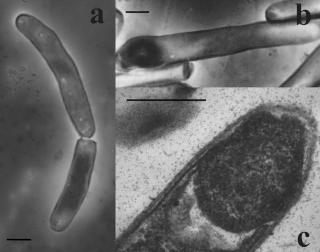The Thermomicrobia is a group of thermophilic green non-sulfur bacteria. Based on species Thermomicrobium roseum and Sphaerobacter thermophilus, this bacteria class has the following description:

Thermus is a genus of thermophilic bacteria. It is one of several bacteria belonging to the Deinococcota phylum. Thermus species can be distinguished from other genera in the family Thermaceae as well as all other bacteria by the presence of eight conserved signature indels (CSIs) found in proteins such as adenylate kinase and replicative DNA helicase as well as 14 conserved signature proteins (CSPs) that are exclusively shared by members of this genus.
Rubrobacter is a genus of Actinomycetota. It is radiotolerant and may rival Deinococcus radiodurans in this regard.
The Nautiliaceae are a family of bacteria placed in an order to itself, Nautiliales, or in the order Campylobacterales. The members of the family are all thermophilic.
Pelotomaculum is a Gram-positive strictly anaerobic, mesophilic, thermophilic and non-motile bacterial genus from the family of Peptococcaceae.

Carboxydocella is a Gram-positive and obligate anaerobe bacterial genus from the family of Syntrophomonadaceae.
Laceyella is a Gram-positive, thermophilic, spore-forming and aerobic bacterial genus from the family of Thermoactinomycetaceae. The genus Laceyella is namened after the English microbiologist John Lacey.
Planifilum is a Gram-positive and aerobic bacterial genus from the family of Thermoactinomycetaceae.
Ilumatobacter is a genus from the order Acidimicrobiales.
Desulfotignum is a Gram-negative and strictly anaerobic bacteria with a single polar flagellum genus from the family of Desulfobacteraceae.
Naumannella is a bacterial genus from the family Propionibacteriaceae.
Caldanaerobacter is a Gram-positive or negative and strictly anaerobic genus of bacteria from the family of Thermoanaerobacteraceae.
Caldanaerobius is a genus of thermophilic, obligately anaerobic bacteria from the family of Thermoanaerobacteraceae.
Conexibacter is a Gram-positive, non-spore-forming and aerobic genus of bacteria from the family Conexibacteraceae.
Solirubrobacter is a Gram-positive, spore-forming, aerobic, mesophilic and non-motile genus of bacteria from the family Solirubrobacteraceae.
Blastococcus is a Gram-positive, coccoid and aerobic genus of bacteria from the family of Geodermatophilaceae.
Hippea is an obligate anaerobic and moderately thermophilic bacteria genus from the family of Desulfobacteraceae. Hippea is named after the German microbiologist Hans Hippe.
Anaerolineaceae is a family of bacteria from the order of Anaerolineales. Anaerolineaceae bacteria occur in marine sediments. There are a total of twelve genera in this family, most of which only encompass one species. All known members of the family are Gram-negative and non-motile. They also do not form bacterial spores and are either mesophilic or thermophilic obligate anaerobes. It is also known that all species in this family are chemoheterotrophs.
Effusibacillus is a genus of Gram-positive, rod-shaped, aerobic, spore-forming bacteria.
Rhodothermus is a genus of bacteria.

